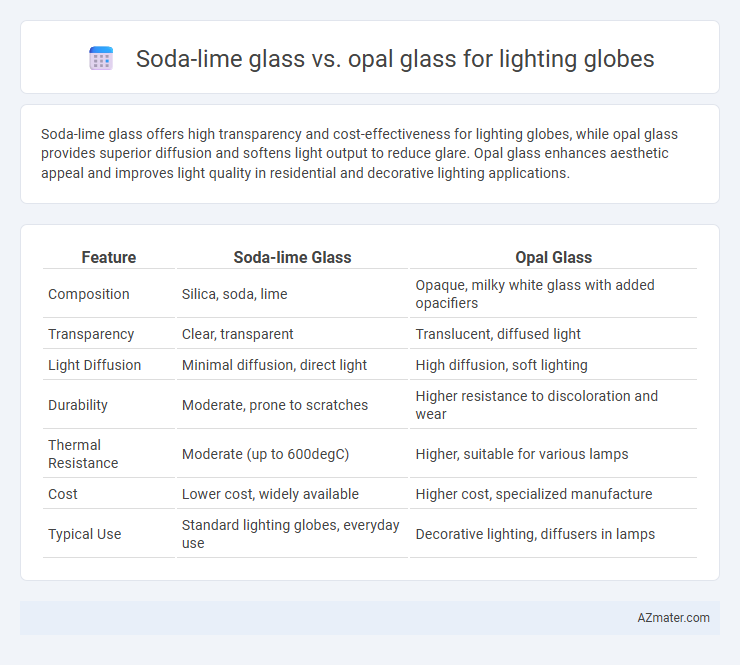Soda-lime glass offers high transparency and cost-effectiveness for lighting globes, while opal glass provides superior diffusion and softens light output to reduce glare. Opal glass enhances aesthetic appeal and improves light quality in residential and decorative lighting applications.
Table of Comparison
| Feature | Soda-lime Glass | Opal Glass |
|---|---|---|
| Composition | Silica, soda, lime | Opaque, milky white glass with added opacifiers |
| Transparency | Clear, transparent | Translucent, diffused light |
| Light Diffusion | Minimal diffusion, direct light | High diffusion, soft lighting |
| Durability | Moderate, prone to scratches | Higher resistance to discoloration and wear |
| Thermal Resistance | Moderate (up to 600degC) | Higher, suitable for various lamps |
| Cost | Lower cost, widely available | Higher cost, specialized manufacture |
| Typical Use | Standard lighting globes, everyday use | Decorative lighting, diffusers in lamps |
Introduction to Glass Types in Lighting Globes
Soda-lime glass is the most commonly used material for lighting globes due to its affordability, clarity, and ease of manufacture, making it ideal for standard illumination purposes. Opal glass, characterized by its milky white, translucent appearance, diffuses light more evenly, reducing glare and creating a softer glow, preferred in decorative and ambient lighting. Each glass type offers distinct optical properties and durability, influencing the choice based on lighting design requirements and performance needs.
What is Soda-Lime Glass?
Soda-lime glass is the most common type of glass used in lighting globes, composed primarily of silica, soda ash, and lime, which provides excellent durability and clarity. This material offers high thermal resistance and mechanical strength, making it ideal for standard lighting applications where cost-effectiveness and straightforward manufacturing are essential. Compared to opal glass, soda-lime glass is typically clear and transparent, allowing for maximum light output but less diffusion of light.
What is Opal Glass?
Opal glass is a type of glass used in lighting globes characterized by its translucent, milky white appearance that diffuses light evenly, reducing glare and creating a soft glow. Unlike soda-lime glass, which is clear and commonly used for general purposes, opal glass contains additives like bone ash or fluorides to achieve its opaqueness and enhanced light diffusion properties. This makes opal glass especially popular for decorative and ambient lighting applications where uniform illumination and aesthetic softness are desired.
Optical Properties: Clarity vs Diffusion
Soda-lime glass offers superior clarity with high light transmittance, making it ideal for applications requiring bright and sharp illumination. Opal glass provides excellent diffusion by scattering light evenly, reducing glare and creating a soft, uniform glow suitable for ambient lighting. The choice between soda-lime and opal glass depends on whether the lighting design prioritizes transparency or diffused light distribution.
Light Transmission and Distribution
Soda-lime glass offers high light transmission, typically around 85-90%, providing clear and bright illumination with minimal color distortion, making it ideal for applications requiring maximum brightness and clarity. Opal glass, in contrast, has lower light transmission, usually between 50-70%, but excels in diffusing light evenly to reduce glare and create a soft, uniform glow suited for ambient lighting. The choice between soda-lime and opal glass depends on whether the priority is maximizing luminous efficiency or achieving balanced light distribution for aesthetic comfort.
Durability and Strength Comparison
Soda-lime glass offers moderate durability and strength, being resistant to everyday impacts but prone to chipping under severe stress, making it suitable for standard lighting globes. Opal glass, characterized by its opaqueness and higher density, provides enhanced strength and superior resistance to thermal shock, resulting in longer-lasting illumination components in demanding environments. The higher alumina content in opal glass contributes to its robust mechanical properties, outperforming soda-lime glass in durability for specialized lighting applications.
Aesthetic Differences in Lighting Fixtures
Soda-lime glass offers a clear, transparent finish that enhances brightness and color accuracy in lighting fixtures, creating a crisp and modern aesthetic. Opal glass diffuses light softly, producing a warm, even glow that reduces glare and adds a vintage or classic allure to fixtures. The choice between soda-lime and opal glass significantly impacts the ambiance, with soda-lime emphasizing clarity and opal providing a more subdued, cozy atmosphere.
Cost and Manufacturing Considerations
Soda-lime glass is more cost-effective and widely used in lighting globes due to its abundant raw materials and simpler manufacturing process, allowing for faster production times. Opal glass, containing added opacifying agents, incurs higher material and processing costs because of its specialized formulation and more complex fabrication techniques. Manufacturers often select soda-lime glass for budget-sensitive projects, while opal glass is preferred when diffusion and aesthetic qualities justify the increased expense.
Environmental Impact of Each Glass Type
Soda-lime glass, widely used for lighting globes, has a lower carbon footprint due to its abundant raw materials and efficient recycling processes, reducing environmental impact through energy savings and raw material conservation. Opal glass, containing additional silica and opacifiers, generally requires higher processing temperatures and energy consumption, leading to increased emissions during production. Despite its aesthetic benefits, opal glass's environmental footprint is larger, but advancements in recycling methods for both types continue to mitigate overall ecological damage.
Choosing the Right Glass for Lighting Applications
Soda-lime glass offers excellent clarity and cost-effectiveness, making it ideal for general lighting applications where transparency and light transmission are crucial. Opal glass, with its diffused light properties, reduces glare and creates a softer, more uniform illumination, preferred for ambient or decorative lighting. Selecting the right glass depends on balancing aesthetic needs, light diffusion requirements, and budget constraints in lighting design.

Infographic: Soda-lime glass vs Opal glass for Lighting globe
 azmater.com
azmater.com